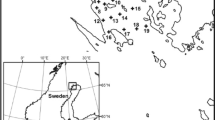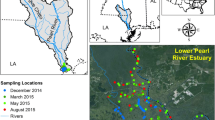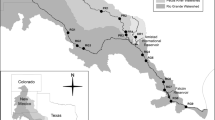Abstract
Flow regulation in lowland rivers has reduced the amount of allochthonous dissolved organic carbon (DOC) entering main channels through less frequent wetting of benches, flood runners and floodplains. The hypothesis tested was that lowland riverine bacterioplankton are DOC limited when flow events are absent and simulating an increase in assimilable DOC similar to that expected during an environmental flow will lead to heterotrophic dominance. Experiments took place in the Namoi River, a highly regulated lowland river in Australia. Specifically, in situ microcosms were used to examine the responses of bacterioplankton and phytoplankton to various additions of DOC as glucose or leaf leachate, with and without additions of inorganic nutrients. The results indicated that ambient DOC availability limited the bacterioplankton for the three seasons over which we conducted the experiments. When DOC was added alone, dissolved oxygen concentrations decreased primarily because of increased bacterial respiration and bacterioplankton growth generally increased relative to controls. Additions of DOC alone led to a pattern of decreased chlorophyll a concentration relative to controls, except for willow leachate. Additions of inorganic nutrients alone increased chlorophyll a concentrations above controls, indicating limitation of phytoplankton. These findings support our hypothesis. Based on the present results, environmental flows should increase the duration of allochthonously driven heterotrophic dominance, thus shifting regulated lowland rivers to more natural (pre-regulation) conditions for greater periods.





Similar content being viewed by others
References
Aitkenhead-Peterson, A., W. H. McDowell & J. C. Neff, 2003. Sources, production and regulation of allochthonous dissolved organic matter inputs to surface waters. In Findlay, S. E. G. & R. L. Sinsabaugh (eds), Aquatic Ecosystems: Interactivity of Dissolved Organic Matter. Academic Press, San Diego, CA.
Anderson, M. J., 2001a. A new method for non-parametric multivariate analysis of variance. Austral Ecology 26: 32–46.
Anderson, M. J., 2001b. Permutation tests for univariate or multivariate analysis of variance and regression. Canadian Journal of Fisheries and Aquatic Sciences 58: 626–639.
Anderson, M. J. & C. J. F. ter Braak, 2003. Permutation tests for multi-factorial analysis of variance. Journal of Statistical Computation and Simulation 73: 85–113.
Anderson, M. J., R. N. Gorley & K. R. Clarke, 2008. PERMANOV + for PRIMER: Guide to Software and Statistical Methods. PRIMER-E, Plymouth.
Anesio, A. M., P. C. Abreu & F. A. de Esteves, 1997. Influence of the hydrological cycle on the bacterioplankton of an impacted clear water Amazonian lake. Microbial Ecology 34: 66–73.
ANZECC, 2000. Aquatic Ecosystems: Australian and New Zealand Guidelines for Fresh and Marine Water Quality. Australian and New Zealand Environment and Conservation Council.
APHA (American Public Health Association), 1998. Standard Methods for the Examination of Water and Wastewater, 20th ed. APHA, Washington, DC.
Baldwin, D. S., J. Wilson, H. Gigney & A. Boulding, 2010. Influence of extreme drawdown on water quality downstream of a large water storage reservoir. River Research & Applications 26: 194–206.
Barmuta, L. A., 2003. Imperilled rivers of Australia: challenges for assessment and conservation. Aquatic Ecosystem Health & Management 6(1): 55–68.
Bell, R. T., K. Vrede, U. Stensdotter-Blomberg & P. Blomqvist, 1993. Stimulation of the microbial food web in an oligotrophic, slightly acidified lake. Limnology & Oceanography 38: 1532–1538.
Benner, R., S. Opsahl, G. Chin-Leo, J. E. Richey & B. R. Forsberg, 1995. Bacterial carbon metabolism in the Amazon River system. Limnology & Oceanography 40: 1262–1270.
Bergström, A. K. & M. Jansson, 2000. Bacterioplankton production in humic Lake Örträsket in relation to input of bacterial cells and input of allochthonous organic carbon. Microbial Ecology 39: 101–115.
Blomqvist, P., M. Jansson, S. Drakare, A. K. Bergström & L. Brydsten, 2001. Effects of additions of DOC on pelagic biota in a clearwater system: results from a whole lake experiment in Northern Sweden. Microbial Ecology 42: 383–394.
Bond, N. R., P. S. Lake & A. H. Arthington, 2008. The impacts of drought on freshwater ecosystems: an Australian perspective. Hydrobiologia 600: 3–16.
Buffam, I., J. N. Galloway, L. K. Blum & K. J. McGlathery, 2001. A stormflow/baseflow comparison of dissolved organic matter concentrations and bioavailability in an Appalachian stream. Biogeochemistry 53: 269–306.
Burford, M. A., A. J. Cook, C. S. Fellows, S. R. Balcombe & S. E. Bunn, 2008. Sources of carbon fuelling production in an arid floodplain river. Marine & Freshwater Research 59: 224–234.
Chessman, B., 2003. IMEF: State Summary Report 1998–2000. NSW Department of Planning, Infrastructure and Natural Resources, Australia.
Cole, B. E. & J. E. Cloern, 1984. Significance of biomass and light availability to phytoplankton productivity in San Francisco Bay. Marine Ecology Progress Series 17: 15–24.
Cole, J. J., S. R. Carpenter, J. F. Kitchell & M. L. Pace, 2002. Pathways of organic carbon utilisation in small lakes: results from a whole-lake 13C addition and coupled model. Limnology & Oceanography 47: 1664–1675.
Cotner, J. B., R. H. Sada, H. Bootsma, T. Johengen, J. F. Cavaletto & W. S. Gardner, 2000. Nutrient limitation of heterotrophic bacteria in Florida Bay. Estuaries 23(5): 611–620.
del Giorgio, P. A. & J. Davis, 2003. Patterns in dissolved organic matter lability and consumption across aquatic ecosystems. In Findlay, S. E. G. & R. L. Sinsabaugh (eds), Aquatic Ecosystems: Interactivity of Dissolved Organic Matter. Academic Press, San Diego, CA.
DIPNR, 2004. Water Sharing Plan for the Upper Namoi and Lower Namoi Regulated River Water Sources. New South Wales Department of Infrastructure, Planning and Natural Resources, Australia.
DLWC, 2000. Namoi: State of the Rivers Report 2000. New South Wales Department of Land & Water Conservation, Australia.
Drakare, S., P. Blomqvist, A.-K. Bergström & M. Jansson, 2002. Primary production and phytoplankton composition in relation to DOC input and bacterioplankton production in humic Lake Örträsket. Freshwater Biology 47: 41–52.
Elser, J. J., L. B. Stabler & R. P. Hassett, 1995. Nutrient limitation of bacterial growth and rates of bacterivory in lakes and oceans: a comparative study. Aquatic Microbial Ecology 9: 105–110.
Farjalla, V. F., F. A. Esteves, R. L. Bozelli & F. Roland, 2002. Nutrient limitation of bacterial production in clear water Amazonian ecosystems. Hydrobiologia 489: 197–205.
Findlay, S., 2003. Bacterial response to variation in dissolved organic matter. In Findlay, S. & R. L. Sinsabaugh (eds), Aquatic Ecosystems: Interactivity of Dissolved Organic Matter. Academic Press, San Diego, CA.
Findlay, S., M. L. Pace, D. Lints & K. Howe, 1992. Bacterial metabolism of organic carbon in the tidal freshwater Hudson Estuary. Marine Ecology Progress Series 89: 147–153.
Hadwen, W. L., C. S. Fellows, D. P. Westhorpe, G. N. Rees, S. M. Mitrovic, B. Taylor, D. S. Baldwin, E. Silvester & R. Croome, 2009. Longitudinal trends in river functioning: patterns of nutrient and carbon processing in three Australian rivers. River Research & Applications. doi:10.1002/rra.1321.
Hall, S. R., M. A. Leibold, D. A. Lytle & V. H. Smith, 2004. Stoichiometry and planktonic grazer composition over gradients of light, nutrients, and predation risk. Ecology 85(8): 2291–2301.
Hinton, M. J., S. L. Schiff & M. C. English, 1997. The significance of storms for the concentration and export of dissolved organic carbon from two Precambrian Shield catchments. Biogeochemistry 36: 67–88.
Hitchcock, J., S. M. Mitrovic, T. Kobayashi & D. P. Westhorpe, 2010. Responses of estuarine bacterioplankton, phytoplankton and zooplankton to dissolved organic carbon (DOC) and inorganic nutrient additions. Estuaries and Coasts 33: 78–91.
Jansson, M., 2003. Allochthonous organic carbon decreases pelagic energy mobilization in lakes. Limnology & Oceanography 48: 1711–1716.
Jansson, M., A. K. Bergström, P. Blomqvist, A. Isaksson & A. Jonsson, 1999. Impact of allochthonous organic carbon on microbial food web carbon dynamics and structure in Lake Örträsket. Arciv für Hydrobiologie 144: 409–428.
Jansson, M., A. K. Bergström, P. Blomqvist & S. Drakare, 2000. Allochthonous organic carbon and phytoplankton/bacterioplankton production relationships in lakes. Ecology 81: 3250–3255.
Jassby, A. D., J. E. Cloern & T. M. Powell, 1993. Organic carbon sources and sinks in San Francisco Bay – variability induced by river flow. Marine Ecology Progress Series 95: 39–54.
Judd, K. E., B. C. Crump & G. W. Kling, 2006. Variation in dissolved organic matter controls bacterial production and community composition. Ecology 87(8): 2068–2079.
Kaplan, L. A. & J. D. Newbold, 1993. Biogeochemistry of dissolved organic carbon entering streams. In Ford, T. E. (ed.), Aquatic Microbiology: An Ecological Approach. Blackwell Scientific Publications, Boston.
Kirchman, D. L., 2003. The contribution of monomers and other low-molecular weight compounds to the flux of dissolved organic material. In Findlay, S. E. G. & R. L. Sinsabaugh (eds), Aquatic Ecosystems: Interactivity of Dissolved Organic Matter. Academic Press, San Diego, CA.
Kobayashi, T. & A. G. Church, 2003. Role of nutrients and zooplankton grazing on phytoplankton growth in a temperate reservoir in New South Wales, Australia. Marine & Freshwater Research 54: 609–618.
Kritzberg, E. S., J. J. Cole, M. M. Pace & W. Granéli, 2006. Bacterial growth on allochthonous carbon in humic and nutrient enriched lakes: results from whole-lake 13C addition experiments. Ecosystems 9: 489–499.
Levene, H., 1960. Robust tests for equality of variances. In: Olkin, I., S. G. Ghurye, W. Hoeffding, W. G. Madow & H. B. Mann (eds), Contributions to Probability and Statistics. Stanford University Press, Menlo Park, CA: 278–292.
Lind, O. T. & E. Barcena, 2003. Response of riverine and transition zone bacterioplankton communities to a pulsed river inflow. Hydrobiologia 504: 79–85.
Malanson, G. P., 1993. Cascades of material and energy. In Birks, H. J. B. & J. A. Wiens (eds), Riparian Landscapes. Cambridge University Press, New York.
Manly, B. F. J., 2006. Randomisation, Bootstrap and Monte Carlo Methods in Biology, 3rd ed. Chapman & Hall, London.
Meyer, J. L. & C. M. Tate, 1983. The effects of watershed disturbance on dissolved organic carbon dynamics of a stream. Ecology 64: 33–44.
Mitrovic, S. M., R. L. Oliver, C. Rees, L. C. Bowling & R. T. Buckney, 2003. Critical flow velocities for the growth and dominance of Anabaena circinalis in some turbid freshwater rivers. Freshwater Biology 48: 164–174.
Oliver, R. L. & C. J. Merrick, 2006. Partitioning of river metabolism identifies phytoplankton as a major contributor in the regulated Murray River (Australia). Freshwater Biology 51: 1131–1148.
Oliver, R. L., S. M. Mitrovic & C. Rees, 2009. Light conditions, salinity and phytoplankton growth in the turbid Darling River, Australia. River Research and Applications. doi:10.1002/rra.1309.
Oviatt, C. A., A. A. Keller, P. A. Sampou & L. L. Beatty, 1986. Patterns of productivity during eutrophication: a mesocosm experiment. Marine Ecology Progress Series 28: 69–80.
Page, K., A. Read, P. Frazier & N. Mount, 2005. The effect of altered flow regime on the frequency and duration of bankfull discharge: Murrumbidgee River, Australia. River Research & Applications 21: 567–578.
Pinhassi, J., L. Gómez-Consarnau, L. Alonzo-Sáez, M. M. Sala, M. Vidal, C. Pedrós-Alió & J. M. Gasol, 2006. Seasonal changes in bacterioplankton nutrient limitation and their effects on bacterial community composition in the NW Mediterranean Sea. Aquatic Microbial Ecology 44: 241–252.
Porter, K. G. & Y. S. Feig, 1980. The use of DAPI for identifying and counting aquatic microflora. Limnology & Oceanography 25: 943–948.
Rees, G. N., G. Beattie, P. M. Bowen & B. T. Hart, 2005. Heterotrophic bacterial production in the lower Murray River, south-eastern Australia. Marine & Freshwater Research 56: 835–841.
Richter, B. D., R. Mathews, D. L. Harrison & R. Wigington, 2003. Ecologically sustainable water management: managing river flows for ecological integrity. Ecological Applications 13: 206–224.
Rier, S. T. & R. J. Stevenson, 2002. Effects of light, dissolved organic carbon, and inorganic nutrients on the relationship between algae and heterotrophic bacteria in stream periphyton. Hydrobiologia 489: 179–184.
Robertson, A. I., S. E. Bunn, P. I. Boon & K. F. Walker, 1999. Sources, sinks and transformations of organic carbon in Australian floodplain rivers. Marine & Freshwater Research 50: 813–829.
Schulze, D. J., 1995. Willows (Salix babylonica) and river redgums (Eucalyptus camaldulensis Dehnh.) as habitat and food for aquatic invertebrates in the River Murray, South Australia. Honours Thesis, University of Adelaide, Adelaide.
Shields, J. & R. Good, 2002. Environmental water in a regulated river system: the Murrumbidgee River planning approach to the determination of environmental needs. Water Science & Technology 45: 241–249.
Sieracki, M. E., P. W. Johnson & J. M. Sieburth, 1985. Detection, enumeration, and sizing of planktonic bacteria by image-analyzed epifluorescence microscopy. Applied and Environmental Microbiology 49: 799–810.
Vink, S., M. Bormans, P. W. Ford & N. J. Grigg, 2005. Quantifying ecosystem metabolism in the middle reaches of Murrumbidgee River during irrigation flow releases. Marine & Freshwater Research 56: 227–241.
Vrede, K., 1996. Regulation of bacterioplankton production and biomass in an oligotrophic Clearwater lake – the importance of the phytoplankton community. Journal of Plankton Research 18: 1009–1032.
Ward, A. K. & M. D. Johnson, 1996. Heterotrophic microorganisms. In Hauer, F. R. & G. A. Lamberti (eds), Methods in Stream Ecology. Academic Press, San Diego, CA.
Westhorpe, D. P., S. M. Mitrovic & B. C. Chessman, 2008. Integrated monitoring of environmental flows: wetting terrestrial organic matter hypothesis. Technical Report: IMEF Phase 1, 1998–2005. NSW Department of Water and Energy, Australia.
Wilcox, H. S., J. L. Wallace & J. P. Benstead, 2005. Effects of labile carbon addition on a headwater stream food web. Limnology & Oceanography 50: 1300–1312.
Acknowledgements
This work was funded by the NSW Government’s Integrated Monitoring of Environmental Flows Program. Dr. John Brayan, Adam Crawford and staff of the NSW Office of Water laboratory are thanked for analysis of water quality parameters. Thanks also to James Hitchcock (UTS) for assisting with the determination of bacterial abundance. The valuable comments and suggestions from two anonymous reviewers are greatly appreciated.
Author information
Authors and Affiliations
Corresponding author
Additional information
Handling editor: N. R. Bond
Rights and permissions
About this article
Cite this article
Westhorpe, D.P., Mitrovic, S.M., Ryan, D. et al. Limitation of lowland riverine bacterioplankton by dissolved organic carbon and inorganic nutrients. Hydrobiologia 652, 101–117 (2010). https://doi.org/10.1007/s10750-010-0322-8
Received:
Revised:
Accepted:
Published:
Issue Date:
DOI: https://doi.org/10.1007/s10750-010-0322-8




